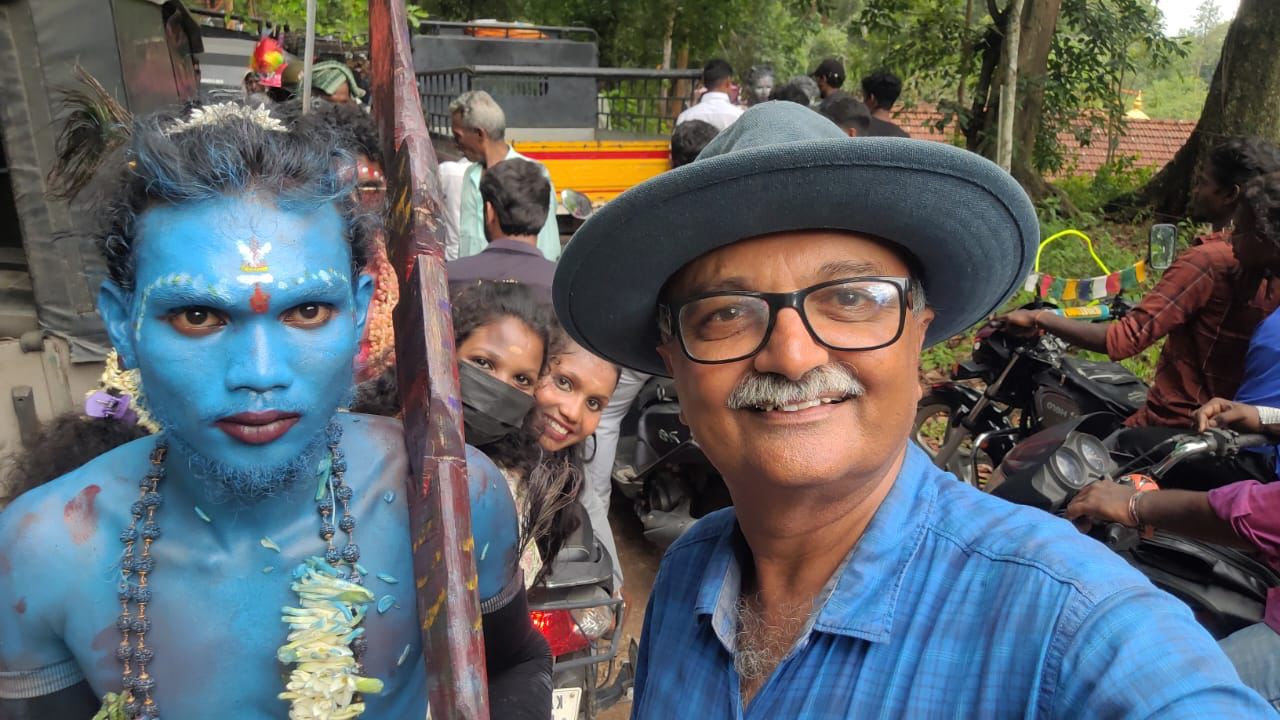By Jammada Ganesh Ayanna

The beauty of tribal culture lies in the underlying principle of social order, where even God’s are to follow moral principles and are not above the concept of justice and punishment. A temple and festival demonstrates this concept in Kodagu.
If the revellers seem offensive to our senses, it is a testimonial against the temptation of a breach of a promise or moral principle, as in the case Lord Aiyappa facing the consequence of one breach even after thousands of years.
Kuruba tribes mainly Bettakurubas in and around Thithimathi and Devarapura villages and across South Kodagu, celebrate this otherwise controversial festival called KUNDE NAMME where reprimanding Lord Aiyappa forms the crux of the festival which takes place on the 3rd Thursday of May every year.
Yore has it that Lord Aiyappa came hunting from Kerala on his horse with his entourage of Dogs, Bettakuruba Tribals and reached a place called Botekaramba near Aiyappa temple in the 350 acre Devakaad (Sacred Grove). Today this town is called Devarapura. In the course of hunting, Mohini – an enchantress and female avatar of Lord Vishnu appeared all of a sudden in the place where today we see the Badrakali temple.
It is believed that Lord Eshwara to test the loyalty of his wife Parvathy came in the form of Botekara Aiyappa. He shot an arrow from Botekaramba, where he had stopped with his entourage. At the place where the arrow fell, Parvati in the form of Mohini appeared. Then Eshwara in the form of Botekara Aiyappa got captivated by Mohini (who in reality was his wife Parvati).
Lord Aiyappa after being enamored by Mohini asked the tribals accompanying him to stay back and went alone near the present Badrakali temple to meet Mohini who being an enchantress trapped Lord Aiyappa romantically. This was seen by a tribal to whom Lord Aiyappa warned not to disclose their romance to others. But this tribesman went back to his people and told in local language ‘KANDAE’ – meaning “I SAW”. ‘KANDAE’ over a period of time became “KUNDE” and is today celebrated as “KUNDE NAMME”. The word KUNDE also refers to a rustic musical instrument made from dry bottle gourd (the seeds make an attractive sound).
On this day after celebrating Kunde Namme in Aiyappa Temple, by around 6 pm devotees go to Badrakali Temple and sacrifice Chicken as an offering to Badrakali. Legend also has it that earlier Humans and Goats were sacrificed to appease Badrakali.
The reason for Kunde Namme’s uniqueness in reprimanding Lord Aiyappa in this festival by tribals is mainly because Lord Aiyappa made his entourage wait and subsequently forgot about them after his affair with Mohini. It is believed that the Lord himself asked the tribals to scold him for his mistake. So to this day the tribals take liberty to reprimand Lord Aiyappa for cheating and keeping them eternally waiting.
A TRUE LESSON IN MORALITY – NEVER CHEAT OR BREAK A PROMISE; EVEN IF YOU ARE A GOD, YOU WILL BE PUNISHED! Also a lesson of what destruction of reputation worldly pleasures can cause.
A further unique feature is that mainly men folk from the Kuruba tribe wear fancy dresses like women wearing frocks, paint their body in garish dark paints, dress in outlandish ware like women exposing their whole body. This in local parlance is called KALII IDDUVOO or Dressing Fancifully.
Apart from this, they shower choicest abuses in local dialect and language to high sounding drum beating, blow-horns and create complete cacophony. The high energy levels, shouting, singing, jumping, dancing and in-turn singing abuses on Lord Aiyappa is something to be seen to be believed. Close to about 10,000 tribals gather in the temple from early morning and by around 4 pm all of them move in circles around the Banyan tree infront of the temple dancing, singing and reprimanding Lord Aiyappa.
Tribals from across South Kodagu congregate in Devarapura Aiyappa and Badrakali temples, which is midway between Thithimathi and Gonikoppal towns. These tribals dressed in crazy dark and garish attire start walking and singing abuses from all over South Kodagu about a day before the actual festival.
Consumption of alcohol is a visible aspect of this festival. Kunde namme is a virtual licence to these tribes for one day to abuse the Lord and their masters and it’s meant to be taken in good humour by all.
For us, at our Oak View Estate, Kaikeri Village, Gonikoppal, the day began when a team of 7 men came home dressed very fancifully and tastefully singing KUNDE NAMAK NAMMA KUNDE KUNDE.
This was the very first year that we experienced this at our Kodagu home; as we normally complete the coffee picking season and return to our home at Mysore. My wife and I were fortunate and excited to have them come to our doorstep in full regalia dancing and singing to drumbeats. I was privileged to participate with all my heart and soul and my wife who was equally excited to have these guests at home, captured pictures of me dancing.
It is customary for them to visit all homes enroute to the Devarapura Temple singing, abusing and dancing requesting for Alms and Offerings. Normally monetary gifts are given to all as they move on from house to house. All the roads and thoroughfares in and around Gonikoppal town is jampacked with these tribesmen who go to all the shops asking for alms.
This Namme is also known as Bodenamme and is popular in most villages of South Kodagu at this time of the year. They block the traffic sing and dance on the roads, but barring stray incidents don’t trouble anyone. Traffic moves at a snails pace and its a wonderful spectacle to watch for the tourists and outsiders from the district.
COEXISTENCE AND APPRECIATING TRIBAL CULTURE IS OF PRIMORDIAL IMPORTANCE FOR OUR VERY SURVIVAL IN KODAGU. ALL OUR FESTIVALS AND CUSTOMARY TRADITIONAL CELEBRATIONS ARE CLOSELY CONNECTED TO OUR TRIBAL MOOLANIVASIS LIKE, KURUBAS, YERAVAS, POLIYAS, KEMBATTIS and the like. Unless we respect their sentiments and join them in celebrating their festivals we get isolated in Kodagu as a community. Celebrating each other’s festivals is critical for longterm peaceful coexistence in Kodagu – so essential in preserving our precious culture, traditions, festivals and all round harmony.
Sannuvanda Family are the Deva Thakkas headed by Sannuvanda Kushalappa. This is an important post similar to a village headman who along with the local villagers, neighbours and BettaKurubas takes upon himself the entire responsibility of this festival under whose guidance this Kunde Namme is conducted yearly). Much of the information is collated from Kushalappa.
Dear readers, this is a very interesting subject like the many we have in Kodagu. I have tried my best to ask knowledgeable local people and also done a little research with what was available to me. But this is a vast subject which needs further research to come to a clear conclusion about this unique festival and similar ones at other locations in South Kodagu. I would be delighted if this article triggers others who have witnessed similar festivals to add to what I have written.
Comment from CLN News and Research Desk:
Tribals who existed in Kodagu with their unique beliefs and customs relate to Aiyappa in many avatars. The story mentioned above is one of many. However the key takeaways from these festivals are to do with:
- participation by all communities in festivals to forge bonding and interdependency. In many such festivals, Kodavas are the thakkas providing administrative and financial support with responsible leadership.
- discipline, integrity and respect go hand in hand. Even the Gods are no exception to this rule!
- the Devarapura Namme is one of many such similar festivals. The most recent being conducted at Parane.



Very well written
Respecting and keeping our native culture alive is the true identity of our civilisation. One should be proud of our ancestors and those who are not are like people without any identity.
The religions with their false ego of superiority are responsible for imposing their culture over the native cultures and have in reality destroyed the harmony in nature.
Deviprasad
All these festivals are relevant with the ultimate agenda being to promote “oneness” amongst all the communities that follow Kodava culture. This is (and was) necessary to establish the uniqueness of our culture and way of life – where embracing everything to do with Nature and our Ancestors (Guru Karona) was prime.
The Hindu stories need to be taken with a pinch of salt as tribal Gods and Spirits existed in forests well before these stories could be fabricated into our folklore.
A word of concern though – these festivals are meant to be “local” and conducted with some sense of dignity. Drunkenness beyond control and demanding monetary alms on unsuspecting travellers on the highway should be strongly discouraged by all. Man days lost in extended festivals should also be a factor for consideration – the work ethic in Kodagu is unacceptable.
Beautifully compiled.
It is good to see local media making an attempt to report such events that reflect the culture and true intermingling of different communities that personifies the true culture of Kodavas.
The recently concluded Bod Namme at Parane, where my family is from, was the last of Bod festivals. In reality, this festival is a perfect illustration of complete involvement by all the communities that follow the Kodava way of life – each of them from Yeravas, Kurubas, Poleyas, Meda and so on have a distinct responsibility to fulfill in the flow of the festivities….*a remarkable reminder for responsible and effective community building endeavors.*
A word about Hindu Gods creeping into the narrative – it is clearly a latter day “infusion” – something that is not uncommon in the transformation of tribal culture. In my personal opinion this should not be encouraged. We see an alarming saffronisation of our most prominent temples which is not the way it used to be in Kodagu from times immemorial.